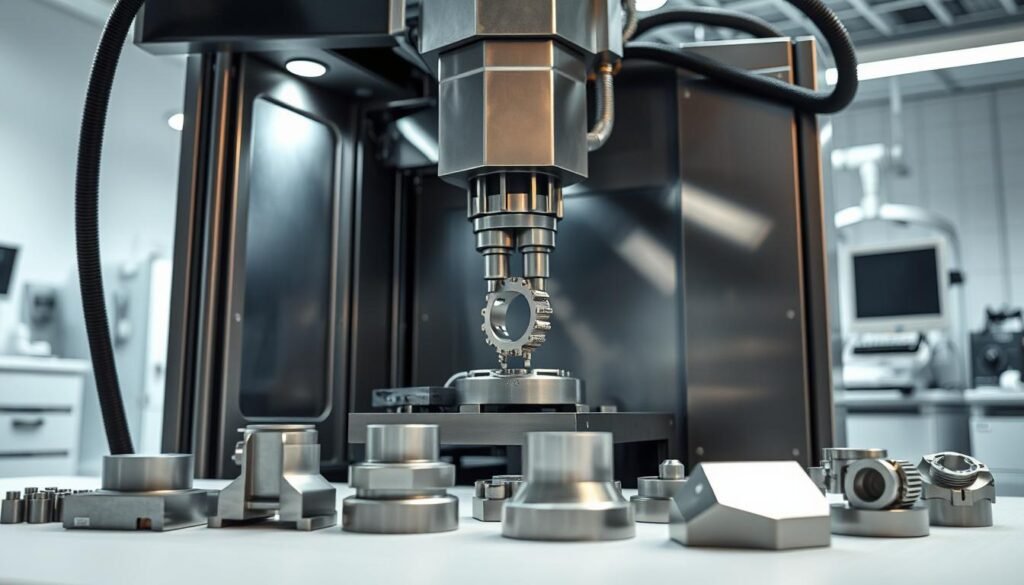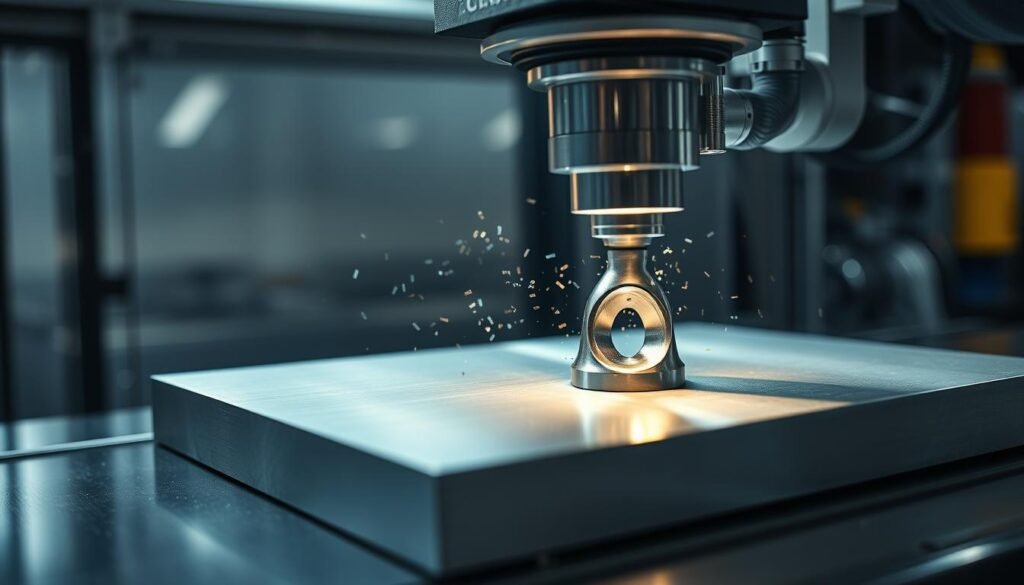CNC (Computer Numerical Control) machining has changed medical device making. It brings top precision and speed. This tech lets makers create detailed parts from materials like metals, plastics, and ceramics.
These parts are key for things like surgical tools, implants, and test equipment parts. CNC machining is vital for making sure these devices are the best quality. This means safer care for patients.
Principales conclusiones
- CNC machining enhances precision in fabricación de dispositivos médicos.
- Biocompatible materials are critical for medical applications.
- CNC technology allows for intricate design capabilities.
- Quality assurance is a key benefit of CNC machining.
- Applications range from surgical instruments to diagnostic equipment.
Introduction to CNC Machining in the Medical Field
CNC machining is a big step forward in making medical devices. It makes production in healthcare better. With CNC machining, makers can make parts that fit exactly what doctors need.
This is key in today’s fast healthcare world. Custom parts help patients get better faster.
CNC technology makes making things faster and more flexible. When there’s a lot of demand, it helps make important medical tools quickly. It uses materials that are safe and strong for medical use.
CNC machining is key for new medical tech. If you want to know more about how it changes medical making, check out este recurso.
Understanding the Importance of Precision in Medical Devices
Precision in medical devices is key for patient safety. Inaccurate tools can cause serious problems. So, making devices with high accuracy is very important.
Advanced CNC machining helps make devices with tight tolerances. This is crucial for tools like surgical instruments and implants.
Impact on Patient Safety
Medical devices need precision to improve patient care. Tools and implants with strict tolerances lower the risk of failure. This is vital for safe medical procedures.
High-precision CNC machining makes components reliable. This builds trust in healthcare products. Technologies like wire EDM and high-speed machining keep these standards high. They are crucial for patient safety in healthcare.
Consistency in Manufacturing
Consistency is vital in making medical devices. The reliability of each part affects treatment success. CNC machining boosts accuracy, making every batch uniform.
This consistency gives medical professionals confidence. They know the tools will work well. Even small differences can matter, so precise manufacturing is key.
Understanding precision in medical devices is crucial. It ensures quality and safe patient care.
In conclusion, precision and consistency in CNC machining are essential. They help the medical industry make high-quality devices. These devices meet standards and improve patient safety.
Benefits of CNC Machining for Medical Device Manufacturing

CNC machining is key in making medical devices. It brings many benefits like better production and quality. These include precision, customization, and saving money. This shows why CNC machining is so important for medical devices.
Alta precisión y exactitud
CNC machining is known for its high precision and accuracy. CNC machines can make parts that other methods can’t. This precision helps meet strict standards, keeping patients safe and devices working well.
Customization and Personalization for Patients
Another big plus is custom medical device machining. Devices can be made just for each patient. This makes them fit better and can help treatment work better. It shows a lot of care for each patient.
Rentabilidad de la producción
At first, CNC machining might seem expensive. But, it saves money in the long run. It uses less material and works faster. This makes it a smart choice for medical device makers.
| Beneficio | Descripción |
|---|---|
| Alta precisión | Achieves tight tolerances, enhancing patient safety. |
| Personalización | Allows for device personalization, improving treatment outcomes. |
| Relación coste-eficacia | Reduces waste and increases productivity, ensuring financial viability. |
CNC Machining for Medical Devices

CNC machining is key in making medical devices. It uses advanced methods to create parts that meet strict standards. These CNC machining methods for medical applications help make both many parts and custom ones for healthcare needs. This helps make precise devices that improve patient care.
In the healthcare world, quality is very important. CNC machining helps keep products consistent and accurate. This makes sure products meet rules and meet the complex needs of medical use.
CNC machining does more than just make products. It helps find new solutions for changing needs. As technology gets better, so do the ways to make things. This leads to better designs and parts for medical use. CNC methods help the medical device field grow, leading to better health solutions.
Common CNC Machining Methods in the Medical Sector

In the medical field, CNC machining is key for making top-notch medical devices. Each method has its own strengths. They meet different needs, ensuring precision and reliability.
CNC Milling Techniques
CNC milling is crucial for making complex shapes in healthcare. It uses rotary tools to create detailed designs. This is vital for the precision needed in medical tools and prosthetics.
Here are the main benefits of CNC milling:
- Ability to produce highly detailed parts
- Efficiency in fabricating large volumes
- Versatility in machining various materials
CNC Turning for Custom Components
CNC turning is great for making cylindrical parts like pins and screws. It’s used a lot in orthopedic applications. This method ensures parts fit perfectly and can be customized.
The main advantages of CNC turning are:
- High precision in circular parts
- Reducción de los residuos de material
- Faster production times for bulk items
5-Axis CNC Machining Advantages
5-axis machining offers great flexibility and precision. It’s perfect for making parts with complex shapes. This is important for advanced medical devices that need exact specifications.
The main benefits of 5-axis machining are:
- Increased accuracy and reduced cycle times
- Ability to work with intricate designs without repositioning
- Enhanced efficiency for multi-faceted components
| Método | Best Use Case | Principales ventajas |
|---|---|---|
| Fresado CNC | Surgical Tools, Prosthetics | Detail, Efficiency, Versatility |
| Torneado CNC | Cylindrical Parts (Pins, Screws) | Precision, Waste Reduction, Speed |
| Mecanizado en 5 ejes | Complex Medical Components | Accuracy, Efficiency, Reduced Repositioning |
Materials Used in CNC Machining for Medical Devices

Elegir bien materials for medical CNC machining is key. It ensures devices are safe and work well. The industry uses metals, plastics, and ceramics made for medical use. Each material helps make devices last longer and work better.
Biocompatible Metals
Biocompatible metals are vital for implants like joints and teeth. Titanium and cobalt-chromium alloys are top picks. They are strong and don’t rust. These biocompatible materials for devices are made to last in the body.
Machining these metals needs special skills. Titanium is hard to work with because it doesn’t conduct heat well.
Plastics Suitable for Medical Applications
PEEK (Polyether Ether Ketone) is a standout plastic for CNC machining. It’s tough and doesn’t react to chemicals. It’s great for prosthetics and tools for surgery. It can handle high heat and cleaning well.
Other materials for medical CNC machining like polypropylene are also good. They’re easy to clean. Using these plastics makes medical devices last longer and work better.
Use of Ceramics in Medical Devices
Ceramics like alumina and zirconia are very hard and don’t wear out easily. They’re perfect for dental and orthopedic implants. They’re safe for the body over time.
But, working with ceramics is tricky because they break easily. Old methods can damage them. New methods like laser and ultrasonic milling help keep them safe. Knowing how to work with these materials is important for making medical devices.
For more info on these materials and how to work with them, check out our full guide on high-precision machining solutions for the medical.
Applications of CNC Machining in Medical Device Manufacturing
CNC machining is key in the medical field. It greatly affects patient care and results. Knowing how it’s used shows its big role in making medical devices.
Surgical Instruments Production
Creating surgical tools needs precision and trustworthiness. CNC machining makes detailed tools like scalpels and forceps. It makes these tools safe and effective for surgeries.
Development of Orthopedic Implants
Orthopedic implants need CNC technology’s advanced skills. It helps make precise implants for hips and knees. This precision means better fits for patients, leading to faster recoveries.
Creation of Diagnostic Equipment Parts
CNC machining is vital for making parts for MRI and CT scanners. These parts must be top-notch to work well. CNC’s quality and accuracy help make sure diagnostic results are reliable and accurate.
Rapid Prototyping in Medical Equipment Development
Rapid prototyping is key in making medical equipment. It helps move ideas to working models fast. Using CNC machining, makers can make designs better and get products to market sooner.
Benefits of Rapid Prototyping
Rapid prototyping in medical devices has big benefits. It lets designers:
- Enhanced Testing: Models are made fast for thorough testing.
- Ahorro de costes: Finding design issues early saves money later.
- Improved Collaboration: Real models help everyone talk and share ideas better.
Iterative Design Improvements
Designs get better with rapid prototyping. It lets designers:
- Refined Features: Changes are made based on what users say.
- Streamlined Production: Prototyping makes making things more efficient.
- Regulatory Readiness: Prototypes meet medical standards, making production easier.
| Aspecto | Creación rápida de prototipos | Prototipos tradicionales |
|---|---|---|
| Timeframe | De días a semanas | De semanas a meses |
| Coste | Lower initial costs | Higher initial costs |
| Flexibilidad | Highly flexible design changes | Limited flexibility |
| Eficiencia material | Minimized waste | Higher wastage |
Challenges in CNC Machining for Medical Devices
CNC machining is key in making medical devices. But, it has many challenges for makers to solve. Knowing these challenges helps keep the industry competitive.
Addressing Material Limitations
Creators face tough material choices for durable, safe devices. Finding materials that pass strict rules is hard. Some materials, like certain polymers and metals, improve device performance.
Choosing the right materials needs creative thinking and careful planning. This is crucial in the design stage.
Ensuring Compliance with Medical Standards
Medical device making rules keep changing. Makers must follow strict standards. This means precise testing and detailed records at every step.
This ensures devices are safe for patients and follow the rules. Makers must add strict quality checks to their work. This helps them stay on track with production and rules.
As the field grows, training for workers and programmers is key. Keeping up with new tech and rules helps makers succeed in a tough market.
For more on dealing with these issues, look into precision CNC machining options. These options meet quality and rule standards in the medical field.
Future Trends in CNC Machining for the Medical Sector
The world of CNC machining in healthcare is changing fast. We see a big push for new ideas and better medical devices. The future depends on using new tech and making things just for each person.
Integration of Advanced Technologies
Automation and AI are key to making things better. They help make products faster and more precise. With these smart systems, quality goes up and wait times go down.
New CNC tech keeps up with the latest standards. This makes sure medical devices are made right and meet new rules.
Emergence of Customized Solutions
New ideas mean medical devices can be made just for you. This change puts the focus on what each patient needs. Soon, making devices just for you will be the norm.
Conclusión
CNC machining for medical devices is key in medical manufacturing. It offers unmatched precision and high quality. This is vital for keeping patients safe and making treatments better.
As we look ahead, new technologies will make CNC machining even better. This will help make medical devices more precise and effective.
The future of making medical devices looks bright. We will see more custom solutions for healthcare. Our goal is to make devices that go beyond what’s expected.
CNC machining in medicine is about more than making things. It’s about improving patient care with reliable and new solutions. We’re committed to keeping quality and precision at the center of what we do.
PREGUNTAS FRECUENTES
What is CNC machining and how is it used in medical device manufacturing?
CNC machining is a way to make precise parts for medical devices. It uses computers to control machines. This makes it possible to create parts from materials like metals, plastics, and ceramics.
These parts are key for things like surgical tools and implants. They help doctors and patients a lot.
Why is precision important in medical device manufacturing?
Precision is key because it ensures parts fit perfectly. If parts don’t fit right, it can be very dangerous. CNC machining helps make sure parts work well.
This makes doctors and patients trust the devices more. It also makes treatments safer and more effective.
What benefits does CNC machining provide for medical devices?
CNC machining has many benefits. It makes parts very precise and accurate. This is important for medical standards.
It also lets doctors make devices that fit each patient perfectly. This makes devices more effective. Plus, it saves money by using less material.
What are the common CNC machining methods used in the medical sector?
There are a few main methods. CNC Milling makes complex shapes for tools and prosthetics. CNC Turning is good for making cylindrical parts like pins.
5-Axis CNC Machining is great for parts with complex shapes. It’s very precise and flexible.
What materials are typically used in CNC machining for medical devices?
Many materials are used. Biocompatible metals like titanium and stainless steel are strong and don’t rust. Advanced plastics like PEEK are easy to clean.
Ceramics are hard and don’t wear down easily. They’re often used in dental and orthopedic devices.
How does rapid prototyping benefit medical equipment development?
Rapid prototyping helps engineers make quick prototypes from CAD models. This lets them test and improve designs fast. It helps get new devices to market quickly.
This means devices can be made to meet patient needs and follow rules faster.
What are some challenges faced in CNC machining for medical devices?
There are a few big challenges. One is finding materials that are safe and last long. Another is keeping up with changing rules to keep patients safe.
What is the future of CNC machining in the medical sector?
The future looks bright. New tech like automation and AI will make things more efficient. We’ll also see more devices made just for each person.
This could change how we treat patients a lot.


